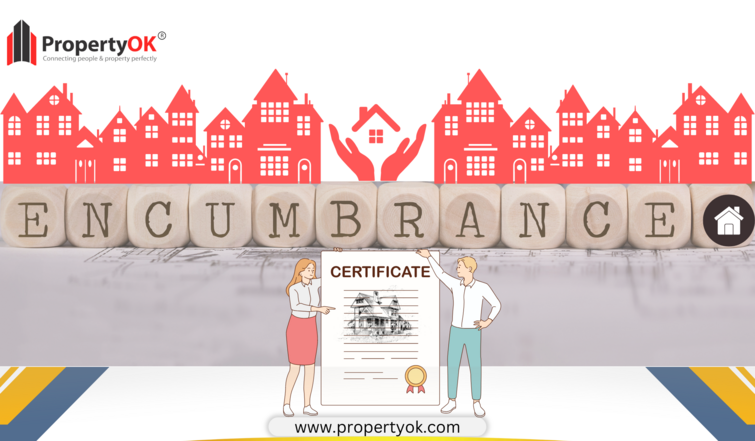If you’re planning to buy a home, you must have come across a document, an ‘Encumbrance Certificate (EC).’ To complete the purchase, EC is among the many documents that are most crucial for home buyers. It is very important to check if there are any legal complications associated with it and to get access to this information. You need an EC certificate to determine if any charges are created on the property. In this blog, we’ll briefly know what an encumbrance is and how to get it.
What is an Encumbrance Certificate (EC)?
Also read: The Importance of Occupancy Certificate(OC) in real estate
In real estate, ‘Encumbrance’ refers to any financial or non-financial claim on any asset by parties other than the title holder. An Encumbrance certificate (EC) is the legal document through which a potential buyer can ascertain that the property is free from any legal and monetary obligations, such as a mortgage or an uncleared loan against the property. It is a certificate of assurance that contains the details of any transaction on the property.
If you purchase a property by availing of a mortgage or if it has been pledged, the lender adds a ‘Lien’ or a charge to the property. This ensures the property owner does not sell the property until the mortgage is paid in full. Therefore, it is a very important document when you purchase or sell a property. It not only provides a homebuyer to secure his legal title over the property but also makes them eligible to obtain loans from banks and financial institutions against the property. You can easily avail EC certificate by visiting the Sub-Registrar’s office.
There are two types of encumbrances certificates, namely
- Form 15
Suppose a property has any encumbrances during the period the applicant applied for the certificate. In that case, an encumbrance certificate on Form 15 is issued by the Sub-Registrar’s office.
- Form 16
Suppose a property does not have any encumbrances during the period for which the applicant has applied for the certificate. In that case, a nil encumbrance certificate on Form 16 is issued by the Sub-Registrar’s office.
Procedures involved in getting an EC in Thane
An individual wishing to obtain an EC in Thane has to avail of the document through the offline process that is in-person.
- To apply for EC, the applicant has to visit the Sub-registrar’s office where the property has been registered.
- Link for the sub-registration office in the state and click on the region’s name under office address and timings to get the entire details.
- The applicant should collect the application form for EC from the respective office and complete it with details along with an attested copy of address proof, details about the property, the fee for obtaining the EC, and its title details. Submit the document with a non-judicial stamp affixed to the respective authority as advised.
- The authorities will inspect the Indexes for details in the specified period and announce the applicable fees that must be paid. You are requested to pay the fees as advised.
- The applicant will issue a receipt containing the transaction details in the specified period and an Acknowledgement ID. If no transactions have occurred, then the applicant will issue a Nil Encumbrance Certificate (NIC).
- The department processes the application request, and the certificate is issued 15-30 days from the date of application.
- An SMS is sent to the applicants notifying the EC certificate status. The applicant should visit the office to collect the certificate on the prescribed date.
- The forms of the certificates and applications are specified in the annexures according to the rules of the Registrations Acts of the respective states. Normally, an EC is issued in Form No.15, an application is made in Form No. 22, and NEC is issued in Form No. 16 of the respective state rules.
Documents needed to get an EC
- Application form
- Applicant’s address proof (attested copy)
- Identity cards such as Aadhar cards, PAN, and Ration card
- A stamp duty paper
- Address of the property and credentials like survey number, document, or patta number
- Applicable fees
- Period for which the EC certificate is required
- The purpose for which the encumbrance certificate is applied for
- Copy of the sale deed of the said property (any sales deed related to the land, the latest or old)
- Copy of Power of Attorney if the attorney holder applies the application
- Property card, if available
Ways to get an Encumbrance certificate online
The steps to apply for an EC differs from one state to another. For example, some states in the country allow users to apply for an EC online, while in some states, you need to visit the respective sub-registrar’s office because they do not allow certificates online.
Given below are the steps on how to get the encumbrance certificate online.
- Visit the respective state’s official website for land registration and select the online EC application option.
- Enter all the required details on the EC application window and click the Save/update option.
- Enter the search period for an EC certificate and click on ‘Calculate Fee’ to check the applicable fees. The fees will be calculated and displayed on the screen.
- Make the payment, and the application will be filed. You’ll then be directed to the ‘Acknowledgement’ window. View the acknowledgment and take a print of the same for reference.
- An evaluation process will be carried out by an inspector from the Land records office and inspection for all the information of the said property for a period.
- After the completion of the inspection, a certificate of encumbrance on the property will be issued with all the transactions that occurred during the specified period. A nil EC would be given if there were no transactions against the property during the period.
- You can track the application status on the official government website and download an encumbrance online.
Uses of EC
After knowing how to obtain an Encumbrance certificate, let’s discuss its uses.
- Buying a property is a huge financial investment which makes EC essential for the customers to enquire for encumbrances because it gets transferred to them with the property owner. An encumbrance certificate ensures the purchaser that the property does now no longer have any financial or non-financial liabilities such as outstanding loan, liens, and leases.
- The certificate also guarantees the purchaser or seller that the property has a free title which is essential in all property-related transactions.
- The EC certificate is also important for those applying for a loan against the property. Generally, financial institutions and banks ask for 10-15 years of encumbrance. Therefore, the homebuyer must obtain an EC to corroborate that they are eligible for a loan.
- Via mutation of property, it also helps the homebuyer to record their property ownership or transfer of the title in the revenue records of municipal corporations.
- If the required land or property tax isn’t paid for more than three years, then the EC certificate is provided to the Panchayat/Village officer to update or replace the land or property tax records.
- It is also used to withdraw PF for a property, buy, and home construction.
Summing Up
The article above narrates all the details about the encumbrance certificate and how to obtain it in Thane. Read the steps carefully and apply for the certificate to register the property or land you wish to buy.
Frequently Asked Questions
- What are the different types of EC?
There are two types of EC, Form 15 and Form 16.
- How to download EC online?
Enter the application ID provided to you while applying for the certificate. Also, enter the captcha and click on the ‘Check Status’ option. The EC certificate will be displayed on the screen. Download the certificate in PDF format.
- What is the importance of EC?
EC is an important document used as evidence of free title or possession against the property. This certificate is required while buying or selling a property to ensure the buyer has no liabilities. If there is a notice charged on the certificate, you must rectify it before purchasing the property. It is also used when applying for a loan against the property to ensure that the property is free of any financial or legal liabilities.
Please add some content.


 Thank You
Thank You